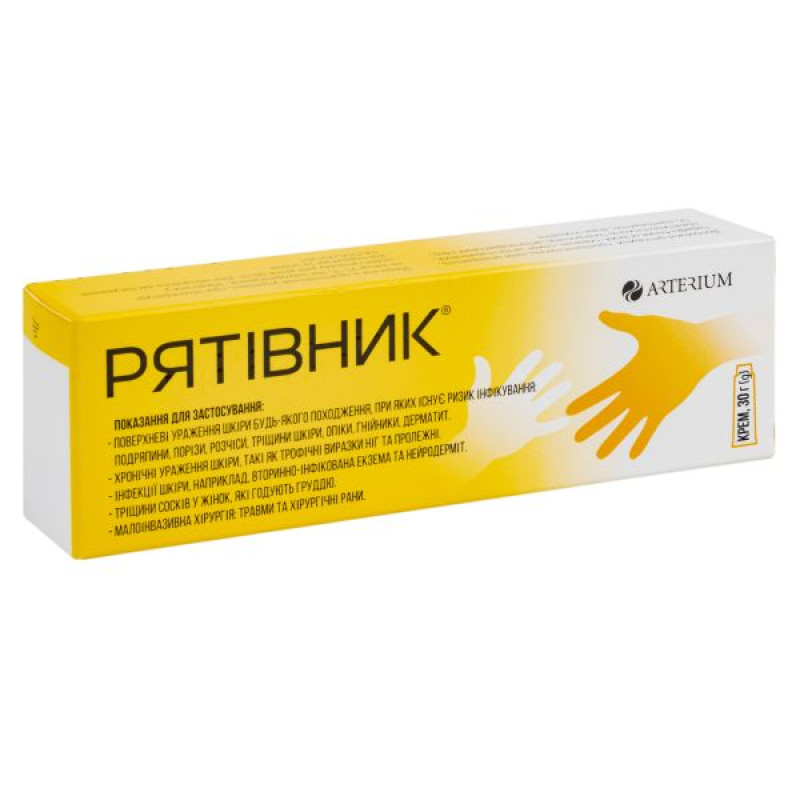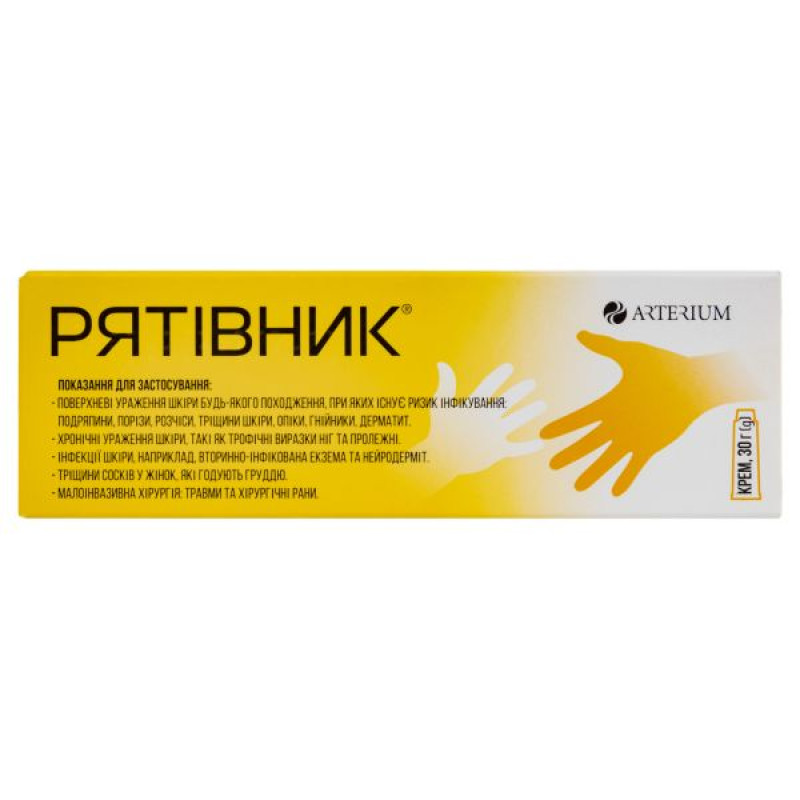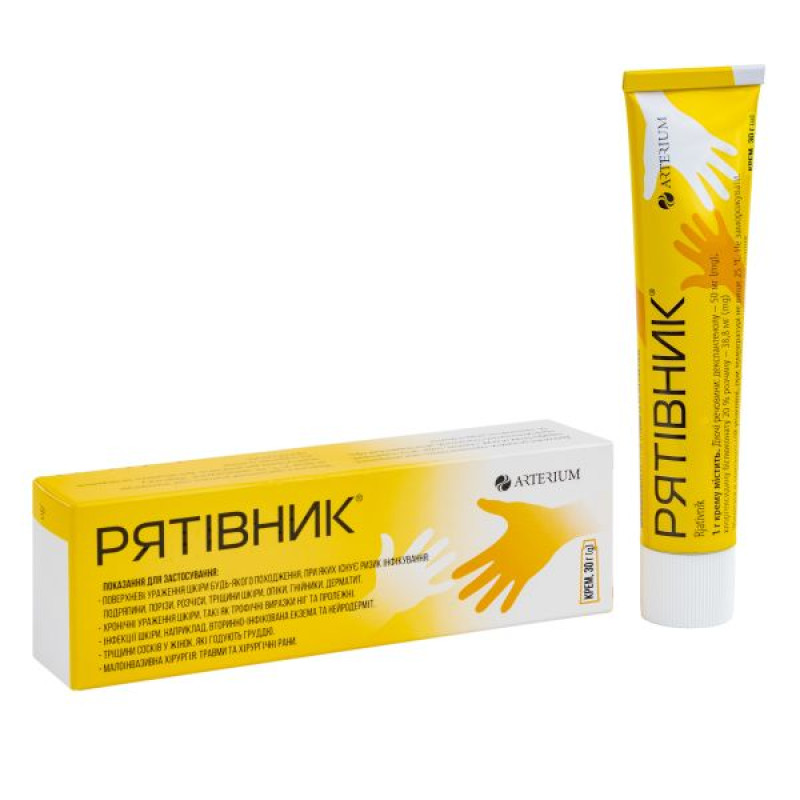Rescuer cream tube 30 g

Instructions for Rescuer cream tube 30 g
Composition
active ingredients: 1 g of cream contains dexpanthenol in terms of 100% substance 50 mg, chlorhexidine bigluconate 20% solution in terms of 20% solution 38.8 mg;
Excipients: propylene glycol, mineral oil, white soft paraffin, squalane, cetostearyl alcohol, polyethylene glycol (macrogol) cetostearyl ether, DL-pantolactone, purified water.
Dosage form
Cream.
Main physicochemical properties: white or almost white cream.
Pharmacotherapeutic group
Dermatological products. Antiseptics and disinfectants. Chlorhexidine, combinations.
ATX code D08A C52.
Pharmacological properties
Pharmacodynamics
Chlorhexidine dihydrochloride is an antiseptic that has a bactericidal effect on gram-positive bacteria, especially sensitive strains of Staphylococcus aureus - microorganisms that are most often associated with skin infections. To a lesser extent, chlorhexidine dihydrochloride is active against gram-negative pathogens. Some species of Pseudomonas and Proteus are resistant to chlorhexidine. It has weak activity against fungi and is not active against viruses.
Dexpanthenol, the active ingredient of the drug Ryativnik®, is rapidly converted into pantothenic acid in cells and acts as a vitamin. Dexpanthenol is absorbed more quickly than pantothenic acid when applied topically.
Pantothenic acid is a component of coenzyme A (CoA). In this form, acetyl-coenzyme A (CoA) plays a leading role in the metabolism of every cell. Thus, pantothenic acid is necessary for the formation and healing of damaged skin and mucous membranes.
Pharmacokinetics
Absorption of chlorhexidine through intact skin has not been detected.
Little is known about the distribution of chlorhexidine in organs and tissues, as its absorption through the skin is minimal. After oral administration of a 300 mg dose to healthy adults, the maximum plasma concentration level of 0.2 μg/ml can be determined after 30 minutes.
Chlorhexidine is virtually not absorbed after topical application to the skin. After oral administration, chlorhexidine is almost completely excreted in the feces.
Dexpanthenol is quickly absorbed by the skin. In skin cells, it quickly converts to pantothenic acid and replenishes endogenous reserves of this vitamin.
In the blood, pantothenic acid binds to plasma proteins (mainly β-globulin and albumin). In healthy adults, the concentration is approximately 500-1000 μg/L and 100 μg/L in blood and serum, respectively.
Pantothenic acid is not biotransformed in the body and is excreted unchanged. 60-70% of an oral dose is excreted in the urine, the rest in the feces. In adults, 2-7 mg is excreted in the urine, in children - 2-3 mg per day.
Indication
Superficial skin lesions of any origin, in which there is a risk of infection: scratches, cuts, abrasions, skin cracks, burns, abscesses, dermatitis.
Chronic skin lesions, such as trophic leg ulcers and pressure sores.
Skin infections, such as secondarily infected eczema and neurodermatitis.
Cracked nipples in women who are breastfeeding.
Minimally invasive surgery: injuries and surgical wounds.
Contraindication
Hypersensitivity to dexpanthenol and/or chlorhexidine, or to any other components of the drug.
Do not apply to a perforated eardrum.
Special safety precautions
Contact with eyes, ears and mucous membranes should be avoided. If the cream gets into the eyes, they should be rinsed with water.
Rescuer® is not recommended for treating skin irritations that have a low risk of infection. Do not use for allergic skin diseases without infectious complications.
Large, heavily contaminated and deep wounds, as well as wounds resulting from bites and punctures, require medical intervention (there is a risk of tetanus). If the wound size remains large within 10-14 days or the wound does not heal, the appropriateness of prescribing the drug should be reconsidered. This is also necessary if there is severe perifocal hyperemia, the wound swells, severe pain appears, purulent exudation increases or the injury is accompanied by fever (risk of sepsis). The drug should not be used to treat infected wounds with abundant purulent exudation.
If symptoms persist or the condition worsens, you should consult a doctor.
Interaction with other medicinal products and other types of interactions
Chlorhexidine is incompatible with saponifying agents and other anionic compounds. Ryativnik® is not recommended for use simultaneously with other antiseptics to prevent their mutual influence (anti-reaction or inactivation).
Use during pregnancy or breastfeeding
Animal reproductive studies have not revealed any risks to the fetus. However, Ryativnik® should not be used on large surfaces during pregnancy, as there are no data from controlled studies in pregnant women.
The drug can be used by women during breastfeeding, but application to large areas of skin should be avoided. If the drug is used to treat cracked nipples, it should be washed off before breastfeeding.
Ability to influence reaction speed when driving vehicles or other mechanisms
No effect.
Method of administration and doses
Adults and children over 1 year of age should apply the drug once or several times a day, depending on the need, to previously cleansed affected areas of skin.
The daily dose with multiple applications should not exceed 5 g of cream.
If necessary, bandages can be applied.
The frequency of cream application and duration of treatment are determined individually on the recommendation of a doctor, depending on the clinical signs of skin damage.
Children
The drug should be used in children over 1 year of age.
Overdose
With topical application of the drug, cases of overdose are unknown.
Dexpanthenol, even in high doses, is well tolerated and considered non-toxic. Hypervitaminosis is unknown.
There is data on a case of elevated aminotransferase levels after self-poisoning with chlorhexidine.
Irritation may often occur after repeated topical application to the same areas of skin. The drug is intended for the treatment of superficial skin lesions. Application to large areas of skin should be avoided.
Side effects
Immune system, skin and subcutaneous tissue disorders: Allergic reactions, including allergic skin reactions such as contact dermatitis, allergic dermatitis, pruritus, erythema, eczema, rash, urticaria, edema, skin irritation, blisters. Hypersensitivity, anaphylactic reactions and anaphylactic shock (potentially life-threatening) with associated laboratory and clinical manifestations including asthma syndrome, mild to moderate reactions potentially affecting the skin, respiratory system, gastrointestinal tract, cardiovascular system including cardiorespiratory failure.
Expiration date
3 years.
Storage conditions
Store in the original packaging at a temperature not exceeding 25 ° C. Do not freeze. Keep out of the reach of children.
Packaging
15 g or 30 g in a tube. 1 tube in a pack.
Vacation category
Without a prescription.
Producer
PJSC "Kyivmedpreparat".
Address
01032, Ukraine, Kyiv, Saksaganskoho St., 139.
There are no reviews for this product.
There are no reviews for this product, be the first to leave your review.
No questions about this product, be the first and ask your question.








